(Originally published in Rolling Stone India, January 2010)
I remember feeling panicky doing this list. Too many titles to consider, and 10 is too less a number. I asked my editor if she would let me make multiple lists, for superhero, romance, manga, sci-fi and so on, but space was a constraint. So I took a deep breath, and chopped down my choices to these 10. Sure, I excluded a lot, but I stand by this list. How many of them have you read?
1. Scott Pilgrim
Writer/Artist: Bryan Lee O’Malley
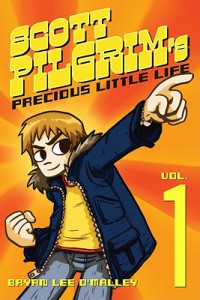 The hardest thing about praising Scott Pilgrim is this – instead of yapping on about how good it is and why one should read it, you could do nothing better than just thrust a copy of the series into someone’s hands. One of the breakaway successes of the decade, Bryan Lee O’Malley’s series is about an everyday rock-band guitarist from Toronto, his dimension-hopping girlfriend and her seven evil ex-boyfriends, and a bunch of the awesomest supporting characters ever. A postmodern cartoon series featuring more pop-culture references than you can shake a stick at, Scott Pilgrim speaks perfect Twentyfirstcenturyese – a truly enduring series of this generation.
The hardest thing about praising Scott Pilgrim is this – instead of yapping on about how good it is and why one should read it, you could do nothing better than just thrust a copy of the series into someone’s hands. One of the breakaway successes of the decade, Bryan Lee O’Malley’s series is about an everyday rock-band guitarist from Toronto, his dimension-hopping girlfriend and her seven evil ex-boyfriends, and a bunch of the awesomest supporting characters ever. A postmodern cartoon series featuring more pop-culture references than you can shake a stick at, Scott Pilgrim speaks perfect Twentyfirstcenturyese – a truly enduring series of this generation.
2. Y The Last Man
Writer: Brian K Vaughn; Artist: Pia Guerra
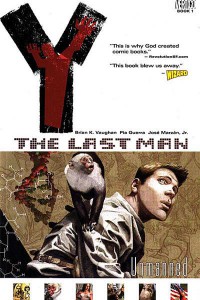 It sounds like the perfect male fantasy – a young man named Yorick Brown and his pet monkey are the only survivors of a planet-wide holocaust that kills every male creature on this planet. But being the last man on earth comes with its disadvantages, as Yorick, accompanied by a scientist and a secret agent, embarks on a journey across the world to find his estranged fiancée and finds himself the target of everyone from male-hating cultists to military strategists. Writer Brian Vaughn brings together a number of themes and plot-lines seamlessly towards a bittersweet ending, and this series remains a high-point of the mainstream sequential storytelling of the decade.
It sounds like the perfect male fantasy – a young man named Yorick Brown and his pet monkey are the only survivors of a planet-wide holocaust that kills every male creature on this planet. But being the last man on earth comes with its disadvantages, as Yorick, accompanied by a scientist and a secret agent, embarks on a journey across the world to find his estranged fiancée and finds himself the target of everyone from male-hating cultists to military strategists. Writer Brian Vaughn brings together a number of themes and plot-lines seamlessly towards a bittersweet ending, and this series remains a high-point of the mainstream sequential storytelling of the decade.
3. Ultimates
Writer: Mark Millar; Artist: Bryan Hitch
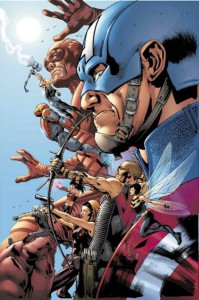 Simple recipe: Take a serving of Silver-age superheroes, remove the tint of nostalgia from the wrapping, add a dash of the current socio-political climate and serve with a healthy dose of cynicism. Mark Millar and Bryan Hitch’s Bush era reimagining of Marvel’s Avengers not only ramped up the action all the way to eleven, but also ended up making the comic a testament to the way the world went insane in the double-noughts.
Simple recipe: Take a serving of Silver-age superheroes, remove the tint of nostalgia from the wrapping, add a dash of the current socio-political climate and serve with a healthy dose of cynicism. Mark Millar and Bryan Hitch’s Bush era reimagining of Marvel’s Avengers not only ramped up the action all the way to eleven, but also ended up making the comic a testament to the way the world went insane in the double-noughts.
4. Blankets
Writer/Artist: Craig Thompson
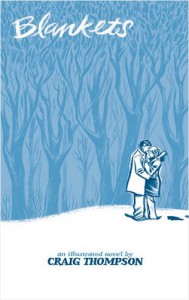 Craig Thompson’s graphic novel is not just a love story. It’s a memoir of a boy’s coming of age, of religion and family and the choices that we make on the way to adulthood. Set in Wisconsin, Blankets follows Thompson’s early life in a fundamentalist Christian family and society, the near-obliteration of his love for art by a din of scorn and piousness, and his first love, Raina, who changes his outlook towards life. In a way, the black-and-white art accentuates the timelessness of the themes addressed by Thompson, making this book one of those rare gateway volumes for casual readers.
Craig Thompson’s graphic novel is not just a love story. It’s a memoir of a boy’s coming of age, of religion and family and the choices that we make on the way to adulthood. Set in Wisconsin, Blankets follows Thompson’s early life in a fundamentalist Christian family and society, the near-obliteration of his love for art by a din of scorn and piousness, and his first love, Raina, who changes his outlook towards life. In a way, the black-and-white art accentuates the timelessness of the themes addressed by Thompson, making this book one of those rare gateway volumes for casual readers.
5. The Goon
Writer/Artist: Eric Powell
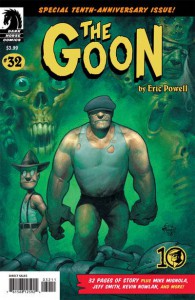 It’s ironic – from winning awards for the best humour publication, The Goon has gone on to win accolades such as Best Continuing Series and Best Multimedia Artist, and even an International Horror Guild award. That’s because Eric Powell’s labour of love effortlessly straddles multiple worlds – at one moment, it features toilet humour and slapstick situations that cater to the lowest common denominator, and in the next it becomes an emotional saga of friendship, loyalty, love and revenge. Add to it the Powell’s completely unique painterly style which has evolved over the years to something that leaps off the printed page and you have a series that just gets better with every chapter.
It’s ironic – from winning awards for the best humour publication, The Goon has gone on to win accolades such as Best Continuing Series and Best Multimedia Artist, and even an International Horror Guild award. That’s because Eric Powell’s labour of love effortlessly straddles multiple worlds – at one moment, it features toilet humour and slapstick situations that cater to the lowest common denominator, and in the next it becomes an emotional saga of friendship, loyalty, love and revenge. Add to it the Powell’s completely unique painterly style which has evolved over the years to something that leaps off the printed page and you have a series that just gets better with every chapter.
6. All Star Superman
Writer: Grant Morrison; Artist: Frank Quitely
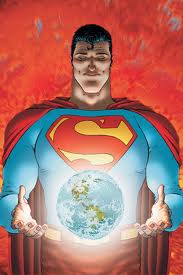 Before Grant Morrison and Frank Quitely began writing their twelve-chapter story of the world’s most familiar superhero, Superman, as a character, was at his nadir – fans complained of the lack of present-day relevance, writers bemoaned the lack of storytelling engines for the characters, others just did not care. But in course of those twelve issues, the writer-artist team not only made Superman resume his rightful place in the comic-book pantheon, but they also crafted a perfect saga of heroism that spanned time, dimensions and universes, with an epic, note-perfect ending. Never before has the Big Blue Guy epitomised truth, justice and humanity so effortlessly as in this Eisner Award winning series.
Before Grant Morrison and Frank Quitely began writing their twelve-chapter story of the world’s most familiar superhero, Superman, as a character, was at his nadir – fans complained of the lack of present-day relevance, writers bemoaned the lack of storytelling engines for the characters, others just did not care. But in course of those twelve issues, the writer-artist team not only made Superman resume his rightful place in the comic-book pantheon, but they also crafted a perfect saga of heroism that spanned time, dimensions and universes, with an epic, note-perfect ending. Never before has the Big Blue Guy epitomised truth, justice and humanity so effortlessly as in this Eisner Award winning series.
7. Fables
Writer: Bill Willingham; Artist: Mark Buckingham
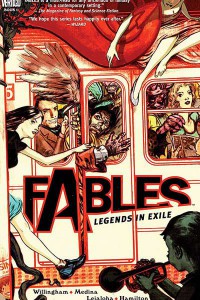 What if fairy tales do not end happily-ever-after? Bill Willingham tries to address that notion in his ongoing series, one in which characters from folklore and fairy tales co-exist among normal people in the present-day, the bulk of them in exile in a neighbourhood in New York City. These characters exist in avatars you had never envisaged. Imagine Snow White as a hard-as-nails politician, Cinderella as an Emma Peele-esque super-spy, and the Big Bad Wolf a bad-ass sheriff. From murder mysteries to swashbuckling adventure to all-out war against a common enemy (who might be the last person you could imagine as a war-mongering Adversary), Fables makes a habit of turning genre conventions on their head.
What if fairy tales do not end happily-ever-after? Bill Willingham tries to address that notion in his ongoing series, one in which characters from folklore and fairy tales co-exist among normal people in the present-day, the bulk of them in exile in a neighbourhood in New York City. These characters exist in avatars you had never envisaged. Imagine Snow White as a hard-as-nails politician, Cinderella as an Emma Peele-esque super-spy, and the Big Bad Wolf a bad-ass sheriff. From murder mysteries to swashbuckling adventure to all-out war against a common enemy (who might be the last person you could imagine as a war-mongering Adversary), Fables makes a habit of turning genre conventions on their head.
8. Planetary
Writer: Warren Ellis; Artist: John Cassaday
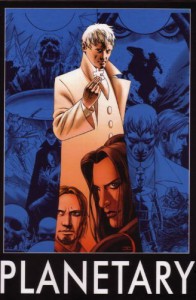 In Planetary, Warren Ellis examines the very mechanisms of what makes genre fiction tick. He weaves archetypes from pulp fiction of the early 20th century – comics, schlocky horror movies, science fiction – into a series that parallels the works of Philip Jose Farmer; a shared universe seen through the eyes of three “archaeologists of the impossible”. While the later half of the series flagged a little because of erratic production schedules, Ellis’s writing and Cassaday’s magnificent artwork made fans across the world gasp when the last issue came out a few months ago, concluding a decade-long series.
In Planetary, Warren Ellis examines the very mechanisms of what makes genre fiction tick. He weaves archetypes from pulp fiction of the early 20th century – comics, schlocky horror movies, science fiction – into a series that parallels the works of Philip Jose Farmer; a shared universe seen through the eyes of three “archaeologists of the impossible”. While the later half of the series flagged a little because of erratic production schedules, Ellis’s writing and Cassaday’s magnificent artwork made fans across the world gasp when the last issue came out a few months ago, concluding a decade-long series.
9. The Walking Dead
Writer: Robert Kirkman; Artist: Charlie Adlard
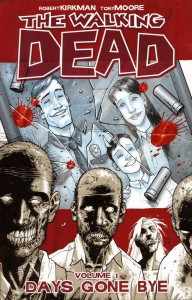 Before zombies took over popular culture this decade, no one could have predicted that a black-and-white indie comic book series where would become the most perfect survival horror tale ever written. Walking Dead is like a George Romero film that does not end. What makes the series so groundbreaking is the way writer Robert Kirkman keeps his characters so vulnerable – there is no guarantee that a cast member would make it through the next chapter, and absolutely no warning about what lies ahead for the protagonists.
Before zombies took over popular culture this decade, no one could have predicted that a black-and-white indie comic book series where would become the most perfect survival horror tale ever written. Walking Dead is like a George Romero film that does not end. What makes the series so groundbreaking is the way writer Robert Kirkman keeps his characters so vulnerable – there is no guarantee that a cast member would make it through the next chapter, and absolutely no warning about what lies ahead for the protagonists.
10. Promethea
Writer: Alan Moore; Artist: JH Williams III
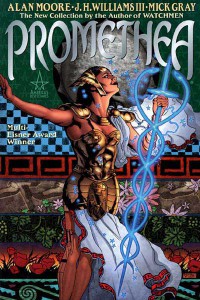 Promethea, on one hand, has the heart-stoppingly beautiful art of JH Williams III, a man whose immaculate visual design makes every page-turn evoke gasps of wonder. On the other, it features the Grand Guru of the graphic novel, Alan Moore, at his psychedelic best, writing a treatise on magic, feminism and mythology. A complicated series that left many readers polarised about the creators’ intent, Promethea remains one of those rare examples of virtuoso artistic expression that stands the test of time.
Promethea, on one hand, has the heart-stoppingly beautiful art of JH Williams III, a man whose immaculate visual design makes every page-turn evoke gasps of wonder. On the other, it features the Grand Guru of the graphic novel, Alan Moore, at his psychedelic best, writing a treatise on magic, feminism and mythology. A complicated series that left many readers polarised about the creators’ intent, Promethea remains one of those rare examples of virtuoso artistic expression that stands the test of time.
Final thoughts:
1. Of course order does not matter. Are you kidding me?
2. Obviously, all series are to be considered in their entirety. With the exception of Fables, which is valid only from issues 1-75, and the two one-shots 1001 Nights of Snowfall and The Last Castle, and Ultimates, where I’ve considered Mark Millar and Bryan Hitch’s two-volume run as canon.
3. The list is very mainstream, glad you noticed. The keyword is “notable”.
